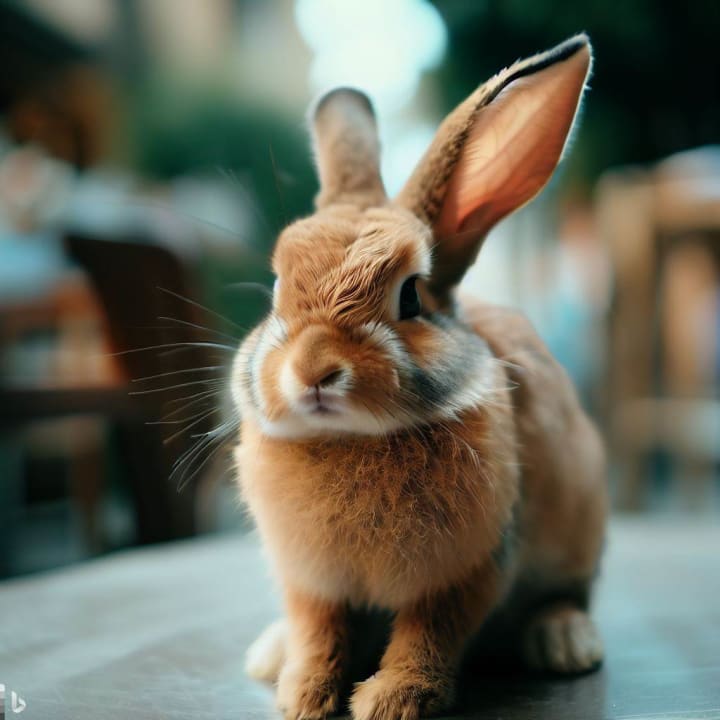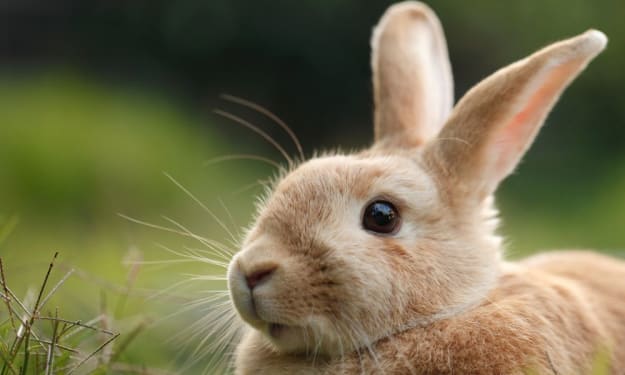The Not-So-Fluffy Truth: Disadvantages of Raising a Rabbit
Hopping into Reality: Navigating the Challenges of Rabbit Ownership

Rabbits have gained popularity as pets in recent years due to their adorable appearance and the perception that they are low-maintenance animals. Many people are drawn to their cute, fluffy demeanor and the idea of having a small, furry companion in their homes.
However, it is important to recognize that raising a rabbit as a pet comes with its own set of challenges and disadvantages. While they may be cute and seemingly easy to care for, there are significant factors to consider before bringing a rabbit into your home. This essay will delve into the disadvantages of raising a rabbit as a pet, shedding light on the responsibilities and potential issues that potential owners should be aware of.

Health and Hygiene Challenges
Rabbits, like any other pets, have their fair share of health and hygiene challenges. It’s important for potential rabbit owners to be aware of these challenges and be prepared to address them.
- Rabbits are prone to specific health issues, such as dental problems and gastrointestinal stasis. Dental problems are a common issue among rabbits due to their continuously growing teeth. Overgrown teeth or malocclusion can cause pain and difficulty in eating. Regular veterinary check-ups are necessary to monitor their dental health and address any issues promptly.
- Another health concern is gastrointestinal stasis, which occurs when the rabbit’s digestive system slows down or stops working. This condition can be life-threatening if not identified and treated early. It is important to be vigilant and watch for signs of reduced appetite, decreased fecal output, or a lack of activity, as these can be indicators of gastrointestinal stasis.
- Frequent grooming is required to prevent matting and hairballs. Rabbits have dense fur that requires regular maintenance to keep it clean and prevent matting. Brushing your rabbit’s fur helps remove loose hair and prevents it from forming mats. Mats can be uncomfortable for rabbits and can even lead to skin irritations or infections.
- Grooming also helps prevent the formation of hairballs, which can be dangerous if ingested. Rabbits groom themselves by licking, and if they ingest too much fur, it can accumulate in their digestive system and cause blockages. Regular brushing can significantly reduce the amount of fur your rabbit ingests, minimizing the risk of hairballs.
- the expenses associated with veterinary care, vaccinations, and spaying/neutering. Responsible rabbit ownership involves providing proper veterinary care for your furry friend. Regular check-ups, vaccinations, and potential treatments for any health issues are necessary to ensure their well-being.
- Rabbit-specific veterinary care can be expensive. It’s important to budget for routine veterinary visits and be prepared for unexpected medical expenses. Depending on your location and the specific veterinary services required, the costs can vary. It’s advisable to research local veterinarians who specialize in rabbit care and inquire about their fees to get an idea of the potential expenses involved.
Additionally, spaying or neutering your rabbit is an important consideration. Apart from preventing unwanted litters, spaying or neutering can help prevent certain health issues, such as reproductive cancers. The cost of spaying or neutering can also vary, so it’s important to factor this into your budget when considering getting a rabbit.

Space and Living Arrangements
Providing the appropriate space and living arrangements for a rabbit is crucial to their overall well-being. It’s important to consider their need for exercise, a secure environment, and the challenges that come with finding suitable housing options, especially in smaller living spaces.
- Rabbits need adequate space to exercise and be active. Unlike cats or dogs, rabbits require more than just a small cage or enclosure to thrive. They are naturally active animals that need room to hop, jump, and binky (a joyful leaping behavior). Confining a rabbit to a small space can lead to frustration, boredom, and even health issues.
- To ensure their physical and mental well-being, it’s essential to provide them with enough space to move around freely. This can be achieved by setting up a designated area for their exercise and playtime, either indoors or outdoors. This area should be safe, secure, and spacious enough for them to stretch their legs and engage in natural behaviors.
- The importance of a secure and rabbit-proofed environment to prevent escapes and injuries. Rabbits are curious creatures with a tendency to explore and chew on things. Ensuring a secure environment is essential to prevent escapes and protect them from potential hazards.
- Rabbit-proofing your home or the designated area where they spend most of their time is crucial. This involves securing electrical cords, removing toxic plants or substances, blocking off small spaces where they can get stuck, and providing appropriate hiding spots and toys to satisfy their natural instincts.
- It’s important to note that rabbits are skilled jumpers and diggers. Ensuring that enclosures have secure and sturdy fencing, and that the flooring is escape-proof, is necessary to prevent accidents and keep them safe.
- the challenges of finding suitable housing options for rabbits in smaller living spaces. One of the challenges that potential rabbit owners may face, especially in smaller living spaces like apartments or condos, is finding suitable housing options for their furry friend.
- Rabbits require enough space to exercise and move around, which can be limited in smaller living spaces. It can be a challenge to find a balance between providing enough space for a rabbit to thrive while also considering the limitations of the living environment.
In such cases, creative solutions may be necessary. Utilizing playpens or exercise pens can provide a temporary enclosed space for rabbits to explore and exercise safely. These can be set up in a larger room or even outdoors, weather permitting.
Another option is dedicating a specific rabbit-proofed room for their exercise and playtime. This room should be free from hazards, with secure fencing and appropriate flooring to prevent escapes and injuries.
It’s important to remember that rabbits still need time outside their enclosures for social interaction and mental stimulation. Even in smaller living spaces, it’s crucial to provide them with daily supervised time outside their designated area to explore and engage with their surroundings.

Time and Attention Requirements
Rabbits are sociable animals that require daily interaction and companionship. It’s important for potential rabbit owners to understand the time and attention requirements involved in caring for these furry companions.
- Rabbits are sociable animals and need daily interaction and companionship. They thrive on social interaction and form strong bonds with their owners. Regular interaction with their human companions helps keep them mentally stimulated and prevents feelings of loneliness or boredom.
- It’s important to spend quality time with your rabbit each day, engaging in activities such as petting, grooming, or simply sitting near them. This helps build trust and strengthens the bond between you and your rabbit.
- The commitment to providing mental stimulation and playtime. In addition to social interaction, rabbits also need mental stimulation and playtime to keep their minds active and engaged. They have natural instincts to explore, forage, and engage in activities that mimic their natural behaviors.
- Providing mental enrichment activities is essential for their overall well-being. This can include providing puzzle toys, hiding treats for them to find, or setting up obstacle courses for them to navigate. These activities not only keep them physically active but also provide mental stimulation and prevent boredom.
- Considerations for individuals with a hectic lifestyle or limited time for pet care. It’s important to consider whether you have the time and commitment to meet the needs of a rabbit, especially if you have a hectic lifestyle or limited time for pet care.
- Rabbits require daily care and attention, including feeding, cleaning their living space, and providing social interaction and playtime. If you have a busy schedule or are frequently away from home for long periods, it may be challenging to meet these requirements.
- In such cases, it’s important to consider alternative options. Hiring a pet sitter or enlisting the help of a trusted friend or family member to care for your rabbit during your absence can ensure that their needs are still met. However, it’s crucial to ensure that these individuals are knowledgeable about rabbit care and can provide the necessary attention and care.
Another consideration is adopting a pair of rabbits. Rabbits are social animals, and having a companion can help alleviate some of the social needs when you are not available. However, it’s important to introduce and bond rabbits properly to ensure compatibility and prevent any potential conflicts.
Before deciding to bring a rabbit into your home, it’s important to honestly assess your lifestyle and available time for pet care. If you find that you are unable to provide the necessary time and attention, it may be best to reconsider getting a rabbit or explore other pet options that better suit your lifestyle.

Diet and Nutritional Considerations
Proper diet and nutrition are crucial for the health and well-being of rabbits. They have specific dietary needs that require attention and consideration from potential rabbit owners.
- Rabbits have specific dietary needs, including a high-fiber, hay-based diet. The foundation of a rabbit’s diet should be high-quality hay, such as timothy hay or orchard grass. Hay provides essential fiber that helps maintain proper digestion and prevents dental issues. It should be available to rabbits at all times.
- In addition to hay, rabbits require a variety of fresh vegetables to ensure a balanced diet. Leafy greens, such as romaine lettuce, spinach, and kale, should be included in their daily meals. It’s important to introduce new vegetables gradually to prevent digestive upset and to avoid feeding them foods that are toxic to rabbits, such as onions or potatoes.
- Commercial rabbit pellets can be part of their diet but should be given in limited quantities. These pellets should be specifically formulated for rabbits and should not contain added sugars or seeds. They should complement, rather than replace, the hay and vegetable portion of their diet.
- The challenges of ensuring a balanced diet with fresh vegetables and limited commercial food. Providing a balanced diet for rabbits can be challenging, especially when it comes to incorporating fresh vegetables and limiting the amount of commercial food.
- Rabbits have sensitive digestive systems, and sudden changes in their diet can lead to digestive issues. It’s important to introduce new vegetables gradually, monitor their response, and adjust accordingly. Additionally, it can be challenging to find a variety of fresh vegetables year-round, depending on your location or the availability of certain produce.
- Limiting the amount of commercial food can be challenging as well. Many commercial rabbit pellets contain additives, sugars, and seeds that are not suitable for a rabbit’s diet. It’s important to carefully read labels and choose high-quality pellets that meet the nutritional needs of rabbits. Moderation is key when it comes to commercial food, as overfeeding can lead to obesity and other health issues.
- the expenses associated with quality rabbit food and hay. Providing quality food and hay for rabbits is an important aspect of their care, but it does come with associated expenses.
- High-quality hay is a staple of a rabbit’s diet, and it should be readily available at all times. The cost of hay can vary depending on the type and quantity purchased. It’s advisable to buy hay in bulk, as it can be more cost-effective in the long run.
- Quality rabbit food, including pellets, can also be an ongoing expense. While it’s important to choose a reputable brand that meets the nutritional needs of rabbits, these products can be more expensive compared to lower-quality alternatives. However, investing in high-quality food can help prevent potential health issues and ensure the overall well-being of your rabbit.
It’s important to budget for these ongoing expenses, including the cost of hay and quality rabbit food. By planning ahead and considering the long-term costs associated with providing a proper diet for your rabbit, you can ensure that their nutritional needs are met without causing financial strain.

Allergies and Sensitivities
It’s important to be aware that some individuals may develop allergies to rabbits, including hay or fur-related allergies. While rabbits are generally considered hypoallergenic, meaning they are less likely to cause allergies compared to other pets like cats or dogs, it is still possible for some people to have allergic reactions.
- Some individuals may develop allergies to rabbits, including hay or fur-related allergies. Hay allergies are relatively common, as rabbits require hay as a staple in their diet. The dust and pollen present in hay can trigger allergic reactions in susceptible individuals. Additionally, some people may be allergic to rabbit fur or dander, which can cause symptoms such as sneezing, itchy eyes, and skin rashes.
It’s important for potential rabbit owners to be aware of their own allergies or sensitivities before bringing a rabbit into their home. If you suspect you may have allergies, it’s recommended to spend time with rabbits or hay before making a decision to see if any symptoms arise.
- The potential health risks and discomfort associated with allergies. Allergies can cause discomfort and impact the quality of life for both the affected individual and the rabbit. Symptoms can range from mild to severe, and they may include sneezing, coughing, watery eyes, itching, and skin rashes.
In some cases, severe allergies can lead to more serious health issues, such as asthma attacks or respiratory problems. It’s important to consult with a healthcare professional if you experience persistent or severe allergy symptoms.
If you or someone in your household has allergies to rabbits or hay, it’s crucial to consider the potential health risks and discomfort associated with these allergies. It may be necessary to explore alternative pet options that are less likely to trigger allergic reactions.

Behavioral Challenges
Rabbits, like any other pet, can exhibit certain behavioral challenges that potential owners should be aware of. It’s important to understand these behaviors and be prepared to address them appropriately.
- potential behavioral issues, such as chewing on furniture, digging, and aggression. Rabbits have natural instincts that can result in behaviors such as chewing on furniture, digging, and occasionally displaying aggression. Understanding these behaviors can help in addressing and managing them effectively.
- Chewing: Rabbits have a strong need to chew to keep their teeth healthy and worn down. They may chew on furniture, wires, or other household items if not provided with appropriate chew toys or materials. Providing plenty of safe and suitable chew toys, such as untreated wood or cardboard, can help redirect their chewing behavior.
- Digging: Rabbits are natural diggers and may exhibit this behavior indoors or in their outdoor enclosures. This can be managed by providing a designated digging area, such as a box filled with safe digging materials like hay or shredded paper. This helps redirect their natural instincts and prevents them from digging in unwanted areas.
- Aggression: While rabbits are generally gentle animals, they may occasionally display aggression. This can be due to fear, territorial behavior, or hormonal changes. It’s important to understand the underlying cause of the aggression and address it accordingly. Consultation with a veterinarian or a qualified animal behaviorist may be necessary to address and manage aggressive behavior in rabbits.
- The need for training and consistent discipline to address behavioral problems. Addressing and managing behavioral challenges in rabbits requires training and consistent discipline. Positive reinforcement techniques, such as rewarding good behavior with treats or praise, can be effective in training rabbits.
- Consistency is key when it comes to discipline. Establishing clear boundaries and consistently reinforcing them helps rabbits understand what is expected of them. For example, if a rabbit is chewing on furniture, redirecting their attention to a suitable chew toy and praising them when they use it can help establish the desired behavior.
It’s important to note that punishment or physical discipline should never be used with rabbits, as it can cause fear and lead to more behavioral problems.
In some cases, seeking professional help from a veterinarian or animal behaviorist may be necessary, especially for more complex behavioral issues. They can provide guidance, behavior modification techniques, and help develop an appropriate training plan for your rabbit.

Conclusion
By taking the time to educate yourself and fully understand the responsibilities of rabbit ownership, you can make an informed decision and ensure that you are able to provide the necessary care and attention that rabbits require.
Other small pets, such as guinea pigs, hamsters, or rats, may be more suitable for individuals with limited time or space. These pets also have their own unique needs and considerations, so it’s important to research and understand their requirements as well.
Ultimately, responsible pet ownership involves taking the time to understand the needs of the animal, providing proper care and attention, and being prepared to address any challenges that may arise. By doing so, you can ensure a happy and fulfilling relationship with your pet.
Remember, adopting a pet is a long-term commitment, and it’s essential to make an informed decision that is in the best interest of both you and the animal.
About the Creator
Pen journey
I can't write
Enjoyed the story? Support the Creator.
Subscribe for free to receive all their stories in your feed. You could also pledge your support or give them a one-off tip, letting them know you appreciate their work.






Comments
There are no comments for this story
Be the first to respond and start the conversation.